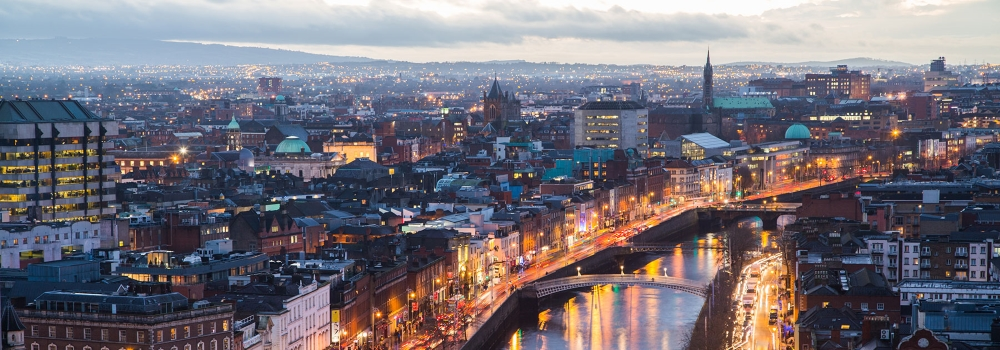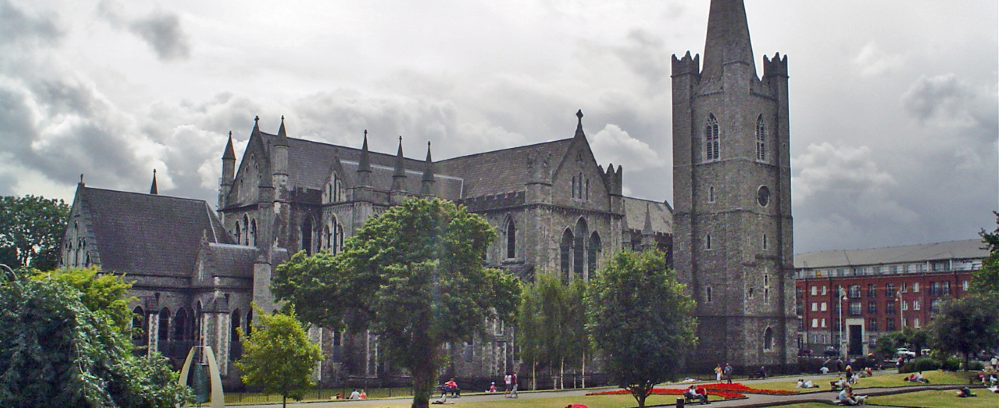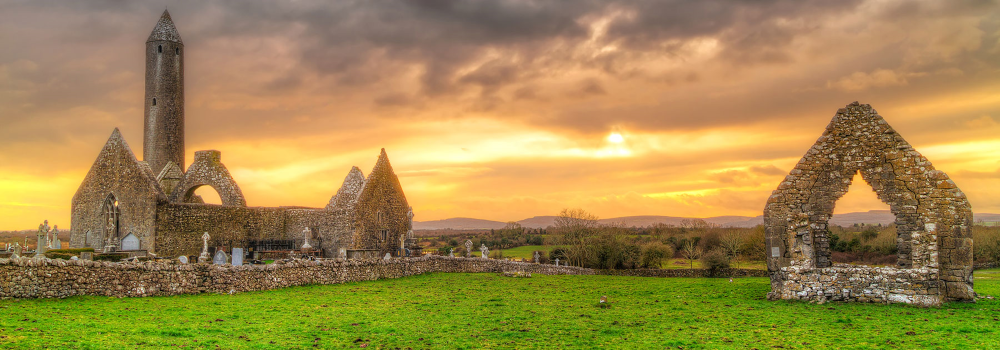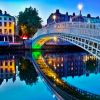Dublin - The fair city ...
Dublin is a surprisingly small town, but with so much charm and good humor, that you can easily take a class in here on a memorable field trip. There are a number of places in Dublin, which is so characteristic of both Ireland and Dublin that it almost (but only almost) is a must to visit them when they are in town.
Getting off to Dublin - find the best hotel!
Guinness Storehouse:
Guinness Storehouse is one of them and it is an attraction without equal. Here one often see cows that are surprisingly long, both outside and inside the museum. The museum contains a review of how to make beer. Here you can also get a taste testing, and there is the opportunity to learn to bestow the optimal Guinness. After the hike you can get a free beer or soda at the top of the building and enjoy the amazing views. The place is a bit of a tourist trap. Here comes a lot of people, and it can be hard to get to the different activities. The exhibition itself is very superficial - here, for example. virtually nothing about Guinness very exciting and controversial history. Here, however, the biggest souvenir shop attached to a museum. A visit can be very rewarding if you are traveling with a marketing class, since they closely to see how branding works and how Guinness has become a worldwide brand.

The Old Jameson Distillery
A little in the same vein, The Old Jameson Distillery. Or it's at least something with alcohol and the Irish culture to do. Here you can visit the old distillery, where Irish culture bottle and one of Ireland's most famous whiskeys are produced for generations. Here are the Irish whiskeys - and author John Jamesons - story told through a comprehensive presentation, and then you hear about the production of whiskey, and sampling the various examples. If you are lucky, you may even be "Accepted Traditional Irish whiskey keys." You can book one of the enthusiastic guides who are looking for a high school class gets everything.
Christ Church Cathedral:
Christ Church Cathedral is like virtually all other major church in Dublin heavily renovated in the 1800s, so there is not much of the original buildings dating back from the 1200s, where Christchurch originally from. However, Christchurch compared to the other buildings preserved some magnificent vaults, one can indulge in. There is also a longer video about church history, that neatly blends it together with Dublin's history. Next to the church is Dublina, a poplært and child-friendly museum about Dublin's Viking and medieval past. Dublina suitable, however, clear to younger children or those with very basic knowledge of both the Vikings and knights, so it is perhaps not the most obvious visit to a high school class from Denmark. But much has been done out of reconstructions, and it is a living museum where the "real" Vikings tells about life. The museum's existence advanced on the Irish pride in their Viking past, and it may well be an exciting prospect to have on a visit.
Trinity College:
The famous Trinity College, where among other Oscar Wilde has gone, is the oldest university in Ireland. It was built in 1592 to Queen Elizabeth I's decree and is now Dublin's city center. There is a lively student environment in the area, which has 16 ha. In The Treasury will find the Book of Kells and Old Library with more than 200,000 ancient books. Book of Kells contains the four gospels of the New Testament, written in calligraphy and beautifully decorated, and is considered to be one of Ireland's national treasures. Be aware that since the place is considered as one of Ireland's national treasures are here crowded by tourists and the queue to see the Book of Kells can be so long that it kills even the most enthusiastic high school teacher ... .for not to talk about her flock.
St. Patrick's Cathedral:
St. Patrick's Cathedral is the largest church in Ireland, and one of the oldest and most majestic cathedrals in the world. The first church on the site was obviously a wooden church, but in 1192 they started the construction of the present stone church, however, is well hidden during later renovations. The cathedral has a remarkable choir decorated with banners and panels decorated with St. Patrick Knights regiment brands that tells about an important part of Irish history. The Church is, as the name suggests, dedicated to Ireland's national saint, and it is also built on the site where St. Patrick according to legend baptized the pagan Irish. The church is also Ireland's largest organ - s & aring; it is quite logical, why the need to plan for the visit to Dublin .... ;-)
But one should be aware that just as Christ Church Cathedral, it has been completely renovated in 1800, so there is not much of the original church back.

Marsh's Library:
An overlooked gem is Marsh's Library, which is located near St. Patricks Cathedral. It contains a unique collection of books. Here you can see - but not touch - books back from the 1500s. But perhaps most impressive, you can see the place where Bram Stoker and James Joyce was studying, and perhaps wrote Ulysses and Dracula. Who knows? Vote No one here is certainly very special and highly recommendable.
Writers Museum:
If you search a little literary theme, it will also be obvious to visit the Writers Museum, which contains a huge exhibition of portraits, manuscripts and personal belongings of famous writers from around the world. The walls are decorated with paintings of famous Irish writers. You can also find exhibits on Ireland's famous writers from the 10th century to the present day as Wilde, Shaw and Yeats. In the museum you will also find a gallery, a bookstore and a cafe. The tour takes place with the audio guide, and takes minutes. 40 min. It is obvious to reading a book or two of one of the Irish writers first ... There are several different places (parks, for example.) In Dublin dedicated to compose clean, as the Irish are very proud of.
Kilmainham Gaol:
Kilmainham Gaol is the prison where many Irish freedom fighters were waiting for execution or banishment to Australia, from 1790`erne to 1924. This is explained by very educational of fine displays and anything else that uses the latest museological thinking. The prison is very closely linked to the history of Ireland, and you get a good understanding of prison life and the conditions they lived in when they were deployed, as well as insight into how Irish society was while incarcerated were used. Especially the fact that the freedom fighters imprisoned in Kilmainham has contributed to that it has an important place in Irish culture and history. It is an interesting visit that can not fail to make an impression on the students.
Dublin Castle:
Dublin Castle, which is the heart of historic Dublin, was built in the years 1208 - 1220. The place is restored in the 17th, 18th and 20th centuries and therefore resembles very little a castle from the 1200s. Dublin Castle is now used only for state visits, but has previously served as a fortress, prison, treasury and Courthouse. The English used in more than 700 years Dublin Castle as the seat of the administration of Irish society, and have historically been at the center of the city's history. Again you get here a good insight into Irish history.
A guided tour takes you include with around the state apartments, where you may look the old throne. In addition comes the underground to the city "source" where the rivers Liffey and Poddle previously met and formed the "black pond" - Dubh Linn - hence the name Dublin. The tour is informative about England / Ireland after the revolution and is told by entertaining guides. Since the visit here is extremely popular recommend an early booking, as there are limitations on the number of visitors groups.
In this review, we have been very focused on specifically the historical thing, because it was what we focused on when we visited Dublin. But we must emphasize that there is also the opportunity to come on some very cool company visits - in addition to Guinness, already mentioned. You can ask your travel agent, they have certainly some good contacts.
Of Dublin
While now in Dublin, it is also an ideal opportunity to get out and see the beautiful Irish countryside.

Wicklow Mountains:
Wicklow Mountains lies example. just south of Dublin. The area consists of granite cliffs and moors, called "boglands". Most of the mountains are scrubbed down the ice and tear, so they look more like hills - in return, the Ice Age formed steep ravines, where there are now rivers and lakes, which together create a beautiful and sometimes rough landscape. Here dull Danish high school students get coloei cheeks of a fresh and memorable hike.
There are many other tours that move out of Dublin, where the focus is on the Celtic history or the beautiful scenery. Just contact your travel agent, they can be helpful in finding both routes, buses and guides.
Belfast:
Belfast which is Northern Ireland's capital city, is also worth a visit. The city's location has formed the basis for that today is an important port with lots of ship construction. Among others there is shipyard Harland and Wolff where the legendary ship Titanic was built. There is a new Titanic museum that tells the fascinating and tragic story of the ship that could not sink - but still did it. See also. Titanic home, as preparation for the trip. Kate and Leo always brings happiness on a dreary Monday afternoon.
For most, Belfast, however, particularly known as a center of fighting between Protestants and Catholics; an internal and intricate conflict that has led to many violent and bloody clashes and acts of terror between the two religious groups. A conflict that very much has characterized the history of Ireland, and the individual irers self-understanding. In recent years, peace between Protestants and Catholics fortunately become a reality - Dog carries the city still in great style marked by conflict. Talk to your travel agent about the possibility of getting a guided tour, where we hear about the conflict and where you will be shown around the key sites and areas in the city.
Keep in mind…
It comes as a surprise to many visitors, but there are many tourists in Dublin. It seems as if specially many Americans to be and experience the motherland, and you often hear more American than you hear Irish. Americans are lovely colorful acquaintances, but they fill up well in a queue ...
Temple bar is a well known district of Dublin, known for their little hippie-like style. In the evening, however, this turned into the wildest party heaven / hell. Here are many fantastic delicious restaurants - and amazing full teens, bachelor parties and other seafood. Atmosphere is fun, and going close. However, it is also important to just fit a little on himself and perhaps spend a night to take from this district to find a "real" Irish pub.
Pleasures of the table ...
Prunes on the disc ... Ireland is not known as the large gourmet country. And it would surely and difficult sin to say that their traditional breakfast of sausages, weird bacon, halved tomato and white pudding is particularly delicious. You probably should rather delete u from this phrase to get closer to the right description ...
Their various types of stew and choweder other hand totally, totally amazing. Stew - or Danish - stew found in countless variations and with very different accessories and can be recommended. Choweder are fish soup and here is also a lot of different variations and they are all the same very delicious.
Ireland is known for its beer culture and it is not without reason. It is impressive to go into any pub and then see the selection of beer, which only specialty bars to offer at home. A perhaps somewhat overlooked fact is that there are as many different delicious ciders that can offer nice variation from the sometimes slightly heavy beer.

Last but not least.
Here at Student Guide, we believe that Dublin is comparable to a small filled chocolate. You can have it in one mouthful, but there are still many different flavors.
You can quickly and easily get to Dublin



